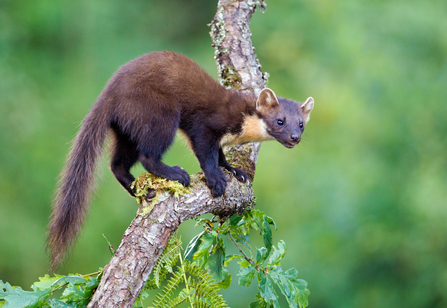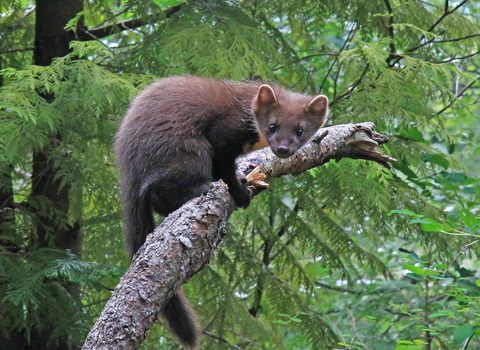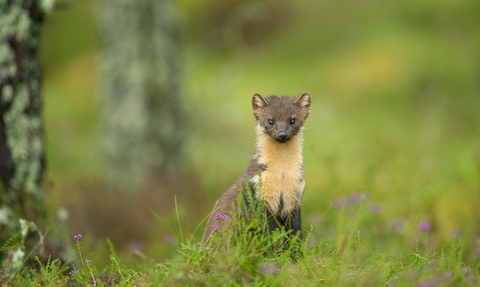
Terry Whittaker/2020Vision
Pine martens in Shropshire
Shropshire Pine Marten Project
The Pine Marten Project was formed by Stuart Edmunds through Shropshire Mammal Group in 2009 and aimed to investigate reported sightings of pine martens (Martes martes) in the county. These elusive mammals, which are related to stoats and weasels, were present until the end of the 1800s, but were presumed to have been persecuted to extinction.
The project has been funded through Crowdfunding initiatives, small grants and donations since 2015. To continue the project in 2021 and 2022, we are delighted to have received additional funding support from the Stepping Stones Project, a Heritage Lottery Funded project run in partnership with other conservations groups and led by The National Trust.
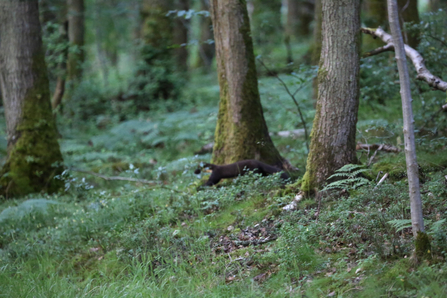
Dave Pearce
The first pine martens in over a century were successfully discovered in Shropshire on July 5th, 2015 when the first ever photograph of a wild pine marten in Shropshire was taken by local wildlife recorder Dave Pearce. Since the photo was taken, our resident pine marten enthusiast Stuart Edmunds has captured astounding video footage of a number of pine martens in the same area using remote camera traps.
At least 20 individuals have been filmed on camera traps in Shropshire since 2015 and in 2021, young pine martens have been recorded, which would suggest that we have a breeding population in the county.
We have confirmed pine marten presence in 9 areas of woodland in the county.
Pine martens are a great indicator of healthy woodland and the discovery of them in Shropshire shows that there is potential for them to make a return across the whole of the UK if lost woodlands can be replanted and better connected.Shropshire Wildlife Trust
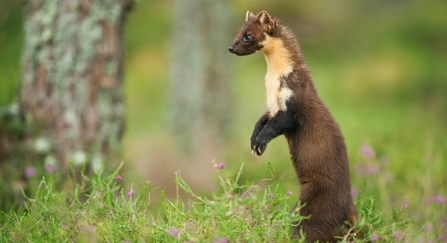
Pine marten (Martes martes) (c) Terry Whittaker/2020VISION
What are the next steps?
Pine martens require huge amounts of woodland habitat to live in. As it becomes increasingly clear that the population in the county are clinging on, it is now essential that awareness of their presence is raised; to protect and improve woodland conditions and to ensure that the martens do not fall victim to persecution.
How we help them
We work with woodland managers and community groups to monitor the whereabouts of pine martens. By gaining a better understanding of where they live, we can work to protect them more.
What we don't do
Shropshire Wildlife Trust has not been involved with the release of captured pine martens in our county and discourages the notion of unofficial releases of any wild animals. Since 2015, official releases have been carried out by Vincent Wildlife Trust and project partners in west Wales and the Forest of Dean, following many years of research to find areas that would be completely suitable for pine martens.
Pine martens are protected by law (see Wildlife and Countryside Act 1981 Schedule 5) and it is illegal to trap and move them without obtaining a license from Natural England. The licensing system ensures that martens involved in translocation projects are fully health-checked before releases and the process must be as smooth as possible to protect the animals from additional stress. Without a period of quarantine and vet checks, there is always a possibility that individual animals could carry parasites and disease that could be released into the area with them. It is also essential that there is consultation with local communities and landowners before captured animals are released elsewhere.
Persecution
Pine martens were once hunted by fur trappers in the UK, but the biggest impact on their numbers has been persecution to eradicate them from areas with a high density of pheasant shoots and gamebird rearing farms. This activity is expected to have caused their original extinction from Shropshire. With higher numbers of pheasant shoots now, it is more likely that martens will fall victim to traps meant for other animals. It is much harder to protect pine martens if they are released unofficially as we wouldn't know where they are, or where to raise awareness of the need to protect them.
Origins
Pine martens are a native species to England, but over-hunting saw them disappear in the country and the British population became restricted to the Highlands of Scotland. The last confirmed record of a pine marten in Shropshire was verified in 1894 (The Flora and Fauna of Shropshire). Anecdotal evidence suggested that a few may have clung on and other martens may occasionally have passed into Shropshire from a small relict population in Wales.
It is possible that escaped martens from private collections and illegally translocated animals could have also settled in Shropshire. Being a species that likes to roam over large distances, there is also potential for marten populations to spread from official release sites in Wales into Shropshire and surrounding counties too.
With work to provide pine martens good quality woodland, with improved connectivity, the future is looking bright for the species in Shropshire and it appears that now are now firmly established in the remotest corners of the county. But that is only possible if we work hard to protect them and create more space for nature overall.
Find out more about the Pine Marten
History of the pine marten
Once found across Britain, the clearance of woodlands, together with predator control, had a devastating effect on the pine marten population and numbers were dramatically reduced.
From the 1930s, following a reduction in trapping pressure, pine martens began to recover in Scotland and the population has slowly expanded and re-colonised many parts of its former range. Today, pine martens are found throughout much of northern and central Scotland, as far south as the Central Belt, with some populations in parts of southern Scotland. Scotland’s population is estimated at 3,700 adult pine martens (Scottish Natural Heritage).
Pine martens have begun to spread over the Scottish/English border and re-colonise areas of Northumberland and Cumbria. Elsewhere in England, there are pine martens of unknown origin in Shropshire and Hampshire. Between 2015 – 2017, the Vincent Wildlife Trust translocated 51 pine martens from Scotland to mid-Wales, leading to the re-establishment of a viable marten population in Wales (Vincent Wildlife Trust).
Species information
An elusive Mustelid, the pine marten is mostly found in the north of the UK, particularly Scotland. Mostly chestnut-brown in colour, the pine marten has a characteristic pale yellow 'bib' on its chin and throat. It has a long, bushy tail.
Diet: It feeds on small rodents, birds, eggs, insects and fruit. Bilberries, Rowan berries and Blackberries make up much of a pine marten's summer diet, often resulting in its 'scats' (droppings) turning blue or red in colour.
Breeding: During the summer mating season, they make shrill, cat-like calls. The following spring, the female will have a litter of between one to five kits, which are independent by autumn.
Habitat: They prefer woodland habitats, climbing very well and living in tree holes, old squirrel dreys or old birds' nests. Pine martens regularly leave their scats on forest trails or in prominent places like boulders to mark their territories.
Average lifespan: up to 8 years.
